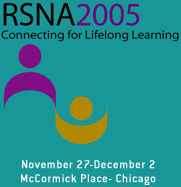
Abstract Archives of the RSNA, 2005
Utaroh Motosugi MD, Presenter: Nothing to Disclose
Tomoaki Ichikawa MD, PhD, Abstract Co-Author: Nothing to Disclose
Tsutomu Araki MD, Abstract Co-Author: Nothing to Disclose
Jun Itakura MD, Abstract Co-Author: Nothing to Disclose
Hideki Fujii MD, Abstract Co-Author: Nothing to Disclose
Pancreaticobiliary reflux (PBR: flow of pancreatic juice into the biliary tract) usually occurs in patients with pancreaticobiliary maljunction, and complicate biliary malignancies. PBR without pancreaticobiliary maljunction is recently reported and ERCP cannot detect that condition. We ivestigated that secretin-stimulating MRCP (SMRCP) can diagnose PBR with or without pancreaticobiliary maljunction.
39 patients who underwent ERCP, SMRCP and measurement of the amylase value of the collected bile were included in this study. Morphological evaluation of a pancreaticobiliary junction was performed by the ERCP. When the ERCP was performed, bile was collected from the CBD and amylase value of the collected bile was measured. The amylase value was assigned as a gold standard of PBR in this study: reflux was present when the amylase value of the collected bile was higher than 1000 IU/L. The method of SMRCP: MRCP (single-shot fast spin echo, TE= maximum) images were obtained every 15 seconds for 10 minutes after bolus injection of secretin at a dose of 50 units. Multi-slice axial MRCP was also performed before and after injection of secretin. The SMRCP images were pegged at positive when the enlargement of gallbladder or CBD was demonstrated after injection of secretin. ERCP and SMRCP images were evaluated blindly and compared with the amylase value of the collected bile.
The final diagnosis of PBR was given in 10 patients (amylase value: 10765- 323500) and remaining 29 patients was jugged no reflux (amylase value: 1- 411). In the patients with PBR, 3 and 1 patients were missed by ERCP and SMRCP, respectively.(sensitivity 70%(7/10) and 90%(9/10)). The 3 patients who were missed by ERCP were correctly diagnosed by SMRCP. In the 29 patients without a PBR, 28 and 18 patients were diagnosed as a normal pancreaticobiliary junction on ERCP and SMRCP, respectively. SMRCP was highly sensitive to PBR but not specific.
SMRCP is functional diagnostic tool and applicable for screening of pancreaticobiliary reflux.
Motosugi, U,
Ichikawa, T,
Araki, T,
Itakura, J,
Fujii, H,
Secretin-stimulating MRCP: Functional Diagnosis of the Pancreaticobiliary Reflux. Radiological Society of North America 2005 Scientific Assembly and Annual Meeting, November 27 - December 2, 2005 ,Chicago IL.
http://archive.rsna.org/2005/4410029.html

